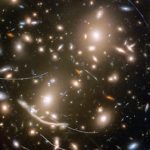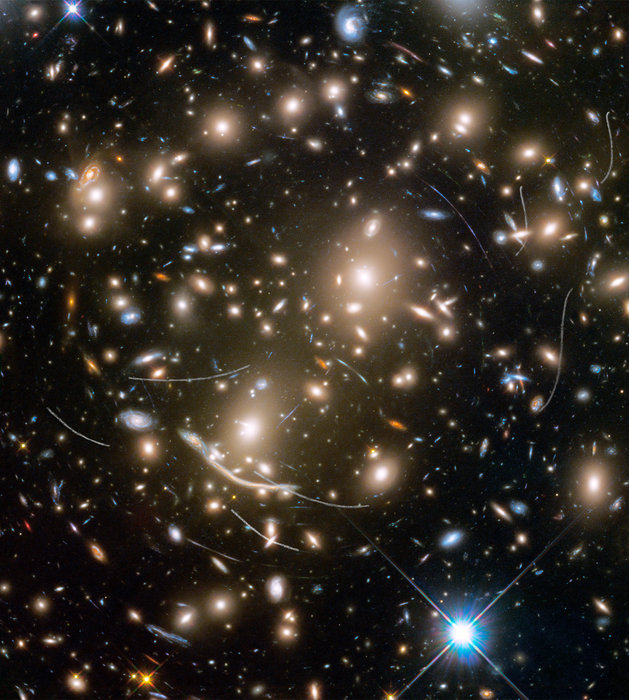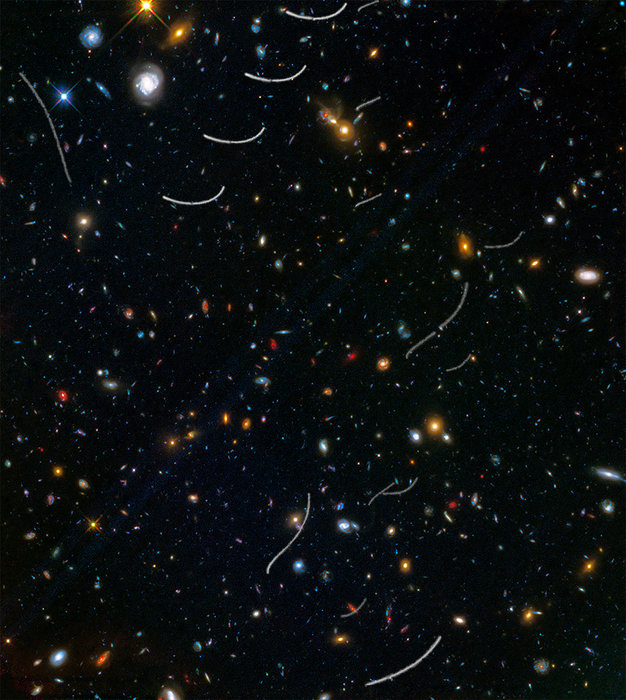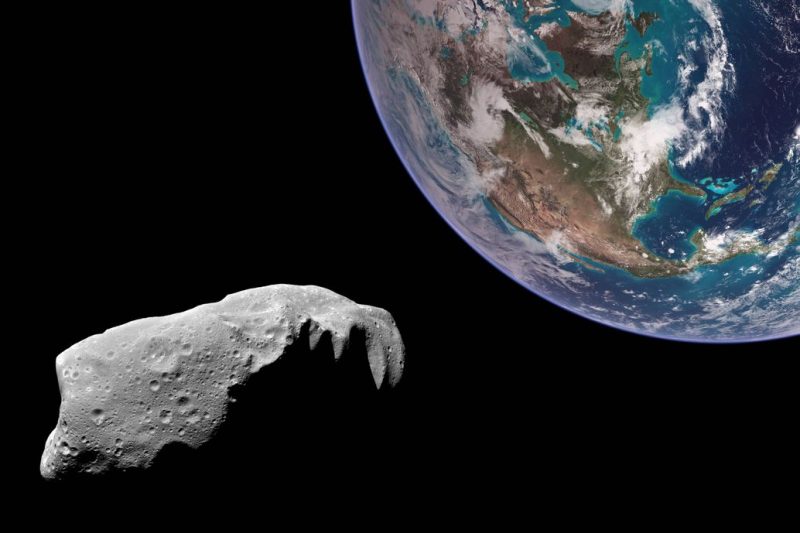

Those streaks are asteroid trails, caught in front of the distant galaxies in the Abell 370 galaxy cluster. The effect of parallax causes the asteroid trails to appear curved. Click here for high-res version. Image via ESA.
Asteroids are common in our solar system, and astronomers find new ones frequently. The first two images on this page, though, show how astronomers have found asteroids while looking for something else, in this case galaxy clusters billions of light-years away. They came across the asteroids by chance. You could say that the asteroids photobombed the galaxy photoshoot!
You can help astronomers find asteroids in this way, too. More about that newly launched Zooniverse project below.
Asteroids – or actually asteroid “trails,” created as the asteroids move in their orbits, closer to us than the stars and galaxies beyond – are seen in these first two images on this page. The images were released by the European Space Agency (ESA) on June 24 and 25, 2019, in conjunction with the annual Asteroid Day festivities in the days leading up to and on June 30.
The trails are created by the movement of the asteroids, as seen in multiple exposures taken by the Hubble Space Telescope. Those multiple exposures can then be combined to create a single image, such as those you see above and below. The images were taken as part of the Frontier Fields program, which aims to use the Hubble Space Telescope to its maximum capabilities.
The astronomers were observing the huge galaxy clusters, containing thousands of galaxies as well as hot gas and dark matter. The asteroids were found accidentally. And now you can participate in a project that aims to find them, intentionally. Keep reading.

Asteroids are members of our solar system; because they’re relatively close to us, we see them move apart from the more distant background of space. This image from the Hubble Space Telescope shows the distant galaxy cluster Abell 370. There are also 20 asteroid trails in this image, resulting from 7 individual asteroids, 5 of which had never been seen before because they were too faint. The curved or S-shaped trails stand out sharply against the background of galaxies. Click here for high-res version. Image via ESA.
How you can help astronomers find asteroids. This month, astronomers launched a new citizen-science project called the Hubble Asteroid Hunter, part of the larger Zooniverse project. Astronomers, planetary scientists and software engineers at ESA and other institutions initiated Hubble Asteroid Hunter. Here’s what ESA said when it announced the new project on June 24:
… a team of astronomers, planetary scientists and software engineers based at ESA and other research institutes has launched a new citizen science project: the Hubble Asteroid Hunter. The project was developed as part of the Zooniverse – the world’s largest and most popular platform for people-powered research.
The new project features a collection of archival Hubble images where calculations indicate that an asteroid might have been crossing the field of view at the time of the observation. Everyone can participate! By identifying the asteroids potentially present in these images and marking the exact position of their trails, you too can help the team improve the asteroid orbit determination and better characterise these objects. Precise knowledge of the orbit is particularly important for so-called near-Earth asteroids, those potentially flying close to our planet.
ESA said the citizen-science project particularly useful for finding near-Earth asteroids, those that could pose a possible risk to our planet. Astronomers are always on the lookout for those, since an impact from one could be catastrophic.
Astronomers know of hundreds of thousands of asteroids in our solar system. The current count is 796,059, according to NASA. Yet we also know there are still many more asteroids waiting to be discovered.
And you can help. Click here to go to Hubble Asteroid Hunter.

You can participate in projects like Hubble Asteroid Hunter. Click here to learn how. The goal is to find new asteroids in archived images, including near-Earth asteroids that could potentially pose a threat. Image via DepositPhotos/ Popular Science.
Bottom line: Although they weren’t specifically looking for them at the time, astronomers found some bonus asteroids while taking some deep-space images of distant galaxy clusters. You can participate in a similar project via Hubble Asteroid Hunter.
from EarthSky https://ift.tt/2LqWXAn


Those streaks are asteroid trails, caught in front of the distant galaxies in the Abell 370 galaxy cluster. The effect of parallax causes the asteroid trails to appear curved. Click here for high-res version. Image via ESA.
Asteroids are common in our solar system, and astronomers find new ones frequently. The first two images on this page, though, show how astronomers have found asteroids while looking for something else, in this case galaxy clusters billions of light-years away. They came across the asteroids by chance. You could say that the asteroids photobombed the galaxy photoshoot!
You can help astronomers find asteroids in this way, too. More about that newly launched Zooniverse project below.
Asteroids – or actually asteroid “trails,” created as the asteroids move in their orbits, closer to us than the stars and galaxies beyond – are seen in these first two images on this page. The images were released by the European Space Agency (ESA) on June 24 and 25, 2019, in conjunction with the annual Asteroid Day festivities in the days leading up to and on June 30.
The trails are created by the movement of the asteroids, as seen in multiple exposures taken by the Hubble Space Telescope. Those multiple exposures can then be combined to create a single image, such as those you see above and below. The images were taken as part of the Frontier Fields program, which aims to use the Hubble Space Telescope to its maximum capabilities.
The astronomers were observing the huge galaxy clusters, containing thousands of galaxies as well as hot gas and dark matter. The asteroids were found accidentally. And now you can participate in a project that aims to find them, intentionally. Keep reading.

Asteroids are members of our solar system; because they’re relatively close to us, we see them move apart from the more distant background of space. This image from the Hubble Space Telescope shows the distant galaxy cluster Abell 370. There are also 20 asteroid trails in this image, resulting from 7 individual asteroids, 5 of which had never been seen before because they were too faint. The curved or S-shaped trails stand out sharply against the background of galaxies. Click here for high-res version. Image via ESA.
How you can help astronomers find asteroids. This month, astronomers launched a new citizen-science project called the Hubble Asteroid Hunter, part of the larger Zooniverse project. Astronomers, planetary scientists and software engineers at ESA and other institutions initiated Hubble Asteroid Hunter. Here’s what ESA said when it announced the new project on June 24:
… a team of astronomers, planetary scientists and software engineers based at ESA and other research institutes has launched a new citizen science project: the Hubble Asteroid Hunter. The project was developed as part of the Zooniverse – the world’s largest and most popular platform for people-powered research.
The new project features a collection of archival Hubble images where calculations indicate that an asteroid might have been crossing the field of view at the time of the observation. Everyone can participate! By identifying the asteroids potentially present in these images and marking the exact position of their trails, you too can help the team improve the asteroid orbit determination and better characterise these objects. Precise knowledge of the orbit is particularly important for so-called near-Earth asteroids, those potentially flying close to our planet.
ESA said the citizen-science project particularly useful for finding near-Earth asteroids, those that could pose a possible risk to our planet. Astronomers are always on the lookout for those, since an impact from one could be catastrophic.
Astronomers know of hundreds of thousands of asteroids in our solar system. The current count is 796,059, according to NASA. Yet we also know there are still many more asteroids waiting to be discovered.
And you can help. Click here to go to Hubble Asteroid Hunter.

You can participate in projects like Hubble Asteroid Hunter. Click here to learn how. The goal is to find new asteroids in archived images, including near-Earth asteroids that could potentially pose a threat. Image via DepositPhotos/ Popular Science.
Bottom line: Although they weren’t specifically looking for them at the time, astronomers found some bonus asteroids while taking some deep-space images of distant galaxy clusters. You can participate in a similar project via Hubble Asteroid Hunter.
from EarthSky https://ift.tt/2LqWXAn

Aucun commentaire:
Enregistrer un commentaire